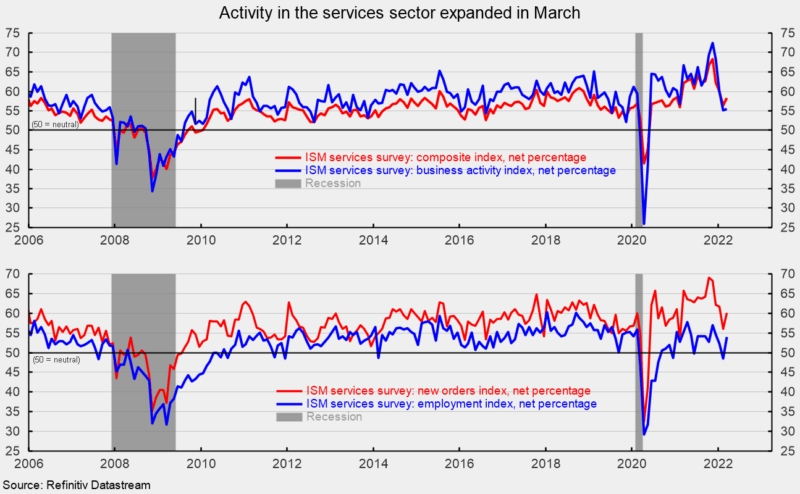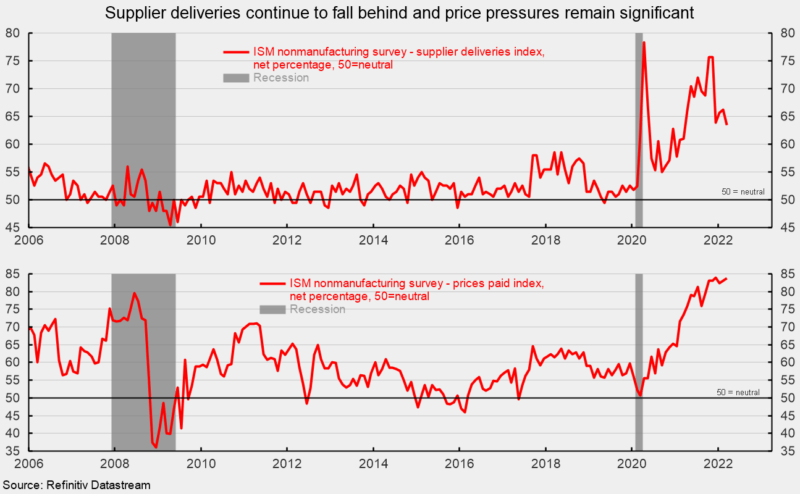Services-Sector Shows Improvement in March
The Institute for Supply Management’s composite services index increased to 58.3 percent in March, rising 1.8 points from 56.5 percent in the prior month. The index remains above neutral and suggests the 22nd consecutive month of expansion for the services sector and the broader economy (see top of first chart). Furthermore, the level is consistent with results of the 2010 through 2019 economic expansion. Respondents to the survey suggest some modest easing of the labor shortages but continued materials shortages, logistical issues, and price pressures as well as new elevated levels of uncertainty due to the Russian invasion of Ukraine.
Among the key components of the services index, the business activity index gained 0.4 points to 55.5 (see top of first chart). That is the 22nd month above 50 and generally in line with the 2010 through 2019 period, though towards the lower end of the range.
The services new-orders index rose to 60.1 percent from 56.1 percent in February, a gain of 4.0 percentage points (see bottom of first chart). The new orders index has been above 50 percent for 22 months and is at a favorable level compared to the last economic expansion.
The nonmanufacturing new-export-orders index, a separate index that measures only orders for export, rebounded in March, coming in at 61.0 versus 53.0 percent in February. Nine industries reported growth in export orders against three reporting declines. However, for all respondents, only about 25 percent said they perform and track separately activity outside the US.
Backlogs of orders in the services sector likely grew again in March as the index increased to 64.5 percent from 64.2 percent. March was the 15th month in a row with rising backlogs. Eleven industries reported higher backlogs in March while one reported a decrease. The services employment index rebounded in March, coming in at 54.0 percent, up from 48.5 percent in February (see bottom of first chart). Thirteen industries reported growth in employment while five reported a reduction. Declining new COVID-19 cases and an easing of public health restrictions were cited as contributing to the slight easing of labor shortages.
Supplier deliveries, a measure of delivery times for suppliers to nonmanufacturers, came in at 63.4 percent, down from 66.2 percent in the prior month but still an elevated result (see top of second chart). It suggests suppliers are falling further behind in delivering supplies to services business, but the slippage decelerated slightly from the prior month. Still, the overall level of the index is high by historical comparison. Sixteen industries reported slower deliveries in March while one reported faster deliveries.
The nonmanufacturing prices paid index rose to 83.8 percent, up from 83.1 percent in February, and just below the all-time high of 83.9 percent in December 2021 (see bottom of second chart). All eighteen industries reported paying higher prices for inputs in March.
The March report from the Institute of Supply Management suggests that the services sector and the broader economy expanded for the 22nd consecutive month in March. Respondents to the survey continue to highlight strong demand but also continued price pressures, materials shortages, and logistics and transportation issues. However, there was some progress on hiring as the latest wave of COVID-19 crested and public restrictions eased. Unfortunately, geopolitical turmoil as a result of the Russian invasion of Ukraine has had a dramatic impact on capital and commodity markets, intensifying price pressures, especially for energy and chemical products, and launching a new wave of potential disruptions to the global economy, supply chains, and business activity.







